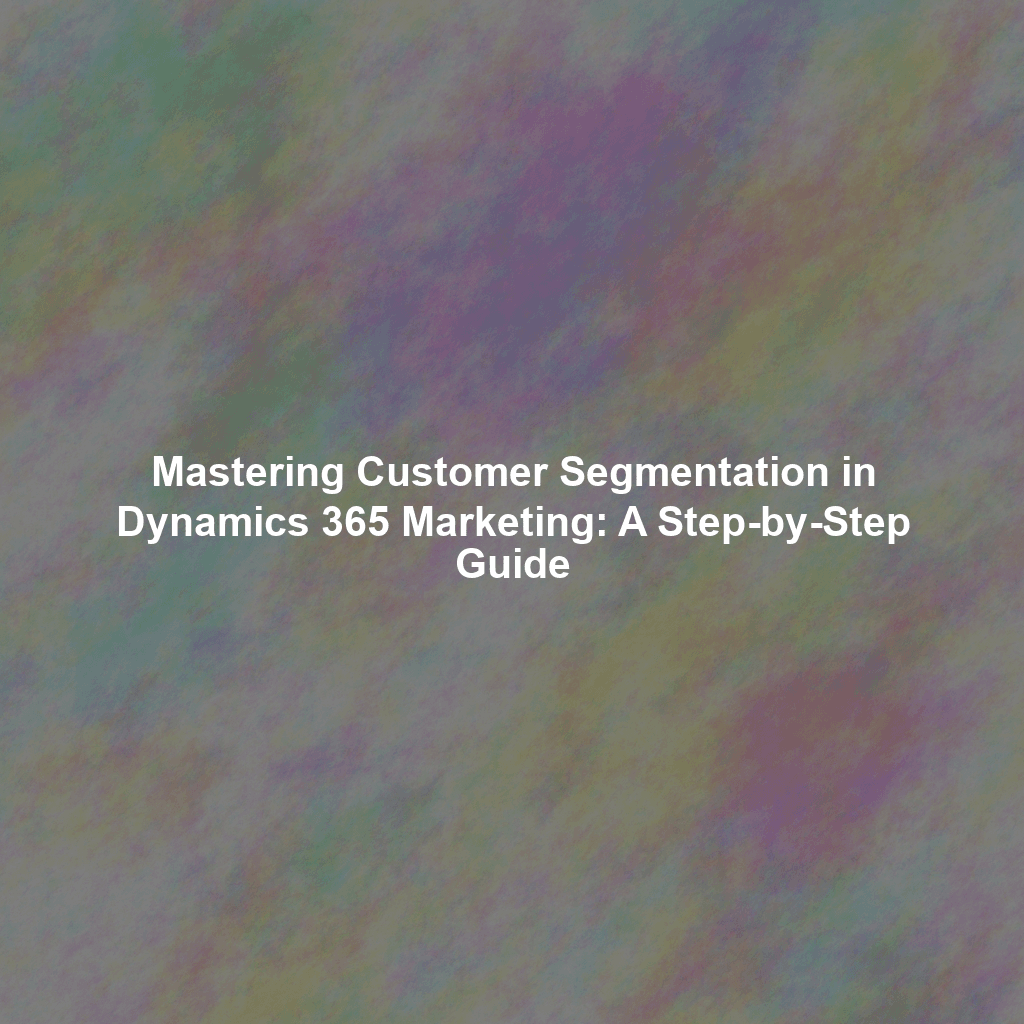Understanding Customer Segmentation in Dynamics 365 Marketing
Customer segmentation is the process of dividing your customer base into groups based on shared characteristics. These characteristics can include demographics, purchase history, website behavior, engagement level, and more. By understanding these segments, you can create marketing campaigns that are more relevant and engaging for each group.
Why is Segmentation Important?
- Increased Engagement: Targeted content is more likely to capture attention and drive interaction.
- Improved Conversion Rates: When you understand your audience, you can tailor your offers and messaging to increase conversions.
- Enhanced Customer Loyalty: Personalized experiences build stronger relationships and foster customer loyalty.
- Optimized Marketing Spend: By focusing on the most receptive segments, you can improve your ROI on marketing investments.
Dynamic vs. Static Segments: Choosing the Right Approach
Dynamics 365 Marketing offers two primary types of segments: dynamic and static. Understanding the difference is crucial for selecting the best approach for your needs.
Dynamic Segments: Automated and Always Up-to-Date
Dynamic segments are rule-based segments that automatically update as customer data changes. They use query logic to include or exclude contacts based on specific criteria. This makes them ideal for segments that need to be kept current, such as “active customers” or “leads interested in a specific product.”
Example: Creating a dynamic segment of customers who have clicked on a specific link in your email campaign within the last 30 days.
- Navigate to Marketing > Customers > Segments.
- Click + New.
- Choose Dynamic segment.
- In the query designer, select the Interaction entity.
- Add a filter to specify the interaction type as “Email Clicked.”
- Add another filter to specify the email message that contains the link.
- Set the date range to “Last 30 Days.”
- Save and Go Live with your segment.
Static Segments: Manual and Controlled
Static segments are lists of contacts that you manually add or remove. They are best suited for segments that are unlikely to change frequently, such as “event attendees” or “customers who have opted out of marketing emails.”
Example: Creating a static segment of attendees for a recent webinar.
- Navigate to Marketing > Customers > Segments.
- Click + New.
- Choose Static segment.
- Manually add contacts to the segment by searching for them or importing them from a file.
- Save and Go Live with your segment.
Behavioral Segmentation: Understanding Customer Actions
Behavioral segmentation focuses on grouping customers based on their actions and interactions with your brand. This can include website visits, email engagement, purchase history, and social media activity. Dynamics 365 Marketing allows you to track these behaviors and create segments based on them.
Leveraging Website Activity
Track website visits, page views, and form submissions to identify customers who are interested in specific products or services. Use this data to create segments for targeted content and offers.
Example:
Creating a segment of customers who have visited the “pricing” page on your website but haven’t made a purchase.
Analyzing Email Engagement
Monitor email opens, clicks, and forwards to identify your most engaged subscribers. Segment these contacts for exclusive offers and personalized communications.
Example:
Creating a segment of customers who have opened at least three of your last five email campaigns.
Purchase History: Understanding Buying Patterns
Analyze purchase history to identify high-value customers, frequent buyers, and customers who are likely to make repeat purchases. Segment these contacts for loyalty programs and upselling opportunities.
Example:
Creating a segment of customers who have purchased products from your “premium” category within the last year.
Leveraging Data Insights for Personalized Campaigns
The key to successful customer segmentation is leveraging data insights. Dynamics 365 Marketing provides robust analytics and reporting capabilities that can help you understand your audience and create more effective segments. Use these insights to refine your segments and personalize your campaigns for maximum impact.
Using Insights to Refine Segments
Regularly review the performance of your segments to identify areas for improvement. Analyze which segments are generating the highest engagement and conversion rates, and adjust your criteria accordingly.
Personalizing Campaign Content
Use dynamic content to personalize your email messages and landing pages based on segment membership. This can include addressing customers by name, recommending relevant products, and tailoring offers to their specific needs.
Conclusion
Mastering customer segmentation in Dynamics 365 Marketing is essential for delivering personalized experiences and driving better results. By understanding the different types of segments, leveraging behavioral data, and using data insights, you can create highly targeted campaigns that resonate with your audience and achieve your marketing goals. Start experimenting with these techniques today and unlock the full potential of Dynamics 365 Marketing.
 Skip to content
Skip to content

